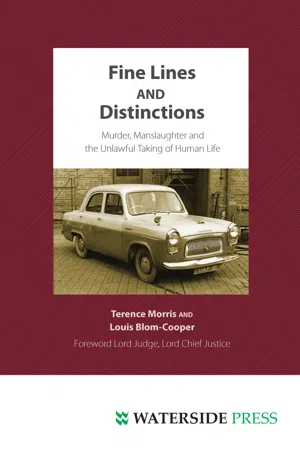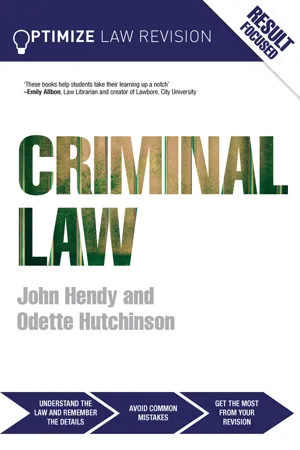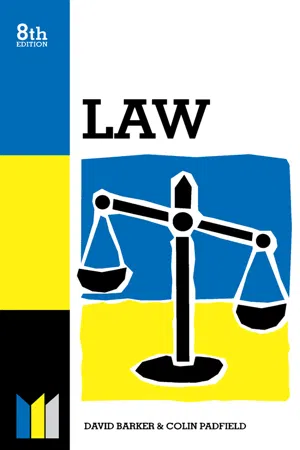Law
Fatal Offences
Fatal offences refer to serious crimes that result in the death of a victim. These include murder, manslaughter, and other offenses that lead to fatal consequences. The legal system treats fatal offences with the utmost severity, often carrying significant penalties upon conviction. These crimes are carefully defined and prosecuted to ensure justice for the victims and their families.
Written by Perlego with AI-assistance
Related key terms
1 of 5
4 Key excerpts on "Fatal Offences"
- eBook - ePub
Fine Lines and Distinctions
Murder, Manslaughter and the UnLawful Taking of Human Life
- Morris, Terrence, Blom-Cooper, Louis(Authors)
- 2011(Publication Date)
- Waterside Press(Publisher)
The mechanistically repetitive statement that murder, no matter the circumstances of the criminal event, is the most heinous of all crimes, and that it must be sharply distinguished from all other forms of unlawful homicide, is thoroughly discredited. Given the variables in homicidal events and the moral opprobrium attaching to any one individual killer, there is no need in contemporary society to label unlawful killings other than by the rubric of a single crime. This chapter seeks to demonstrate both the variable nature of homicides and the moral responsibility for each case.The traditional (or old) definition of the offence of murder was unlawful killing, with malice aforethought, resulting in the death of the victim within a year and a day (a time-limit that no longer applies). In modern times, the emphasis has invariably focused on the state of mind of the accused (the malice aforethought). It is a common misapprehension among non-lawyers that a person can be convicted of murder only if it is proved that the accused intended to kill; in fact only a minority of people convicted of murder possess that extreme intent. It is sufficient for the prosecution to prove an intention to cause really serious injury. If death ensues, however unexpected, unpremeditated, or lacking in intention to kill, the offence of murder is made out, and the mandatory sentence of life imprisonment must follow. It is thus possible to commit a murder not only without wishing the death of the victim but also without the least thought that this might be the result of the assault. Few people would think that this represents a notion of justice.By contrast, where the accused is charged only with an attempt to murder, it is necessary for the prosecution to prove a specific intent to kill; an intention to cause serious injury will not suffice. The case of Dr Nigel Cox points up the absurd illogicality of the law. Dr Cox was tried and found guilty of the attempted murder of a terminally-ill patient by giving her a an injection which had lethal consequences, for which offence he received a 12-month suspended sentence. Had the prosecution been for murder, it would have been necessary only to show that he intended to cause her serious harm.6 - eBook - ePub
- John Hendy, Odette Hutchinson(Authors)
- 2015(Publication Date)
- Routledge(Publisher)
3Non-Fatal Offences Against the PersonUnderstand the law • Can you define each of the offences in this chapter?• Which offences in this chapter are common law offences, and which are statutory offences outlined in the OAPA 1861 ?Remember the details • Can you remember the actus reus and mens rea of each offence?• Can you define each element of the actus reus and mens rea using case law examples?Reflect critically on areas of debate • Do you understand how consent may operate as a defence to an offence in this chapter?• Can you define intention and recklessness accurately and critically discuss them in relation to case law examples?Contextualise • Can you relate these offences to other areas of criminal law such as sexual offences and homicide?Apply your skills and knowledge • Can you complete the example essay and problem questions provided in each section of this chapter using case law and statutes to support your answer?Chapter Map
Elements Chart
Introduction
In this chapter we are going to consider non-Fatal Offences against the person. This is a popular examination topic in its own right, but issues in relation to non-Fatal Offences against the person can overlap with sexual offences, property offences and homicide against the person. This is another area of the criminal law syllabus in which is it vitally important that you have a solid understanding of because this area of law may be related to a significant proportion of your studies.Aim HigherAs you progress through this chapter, think about how these non-Fatal Offences relate to other criminal offences, such as homicide, sexual offences or property offences. This will help your understanding of these and other offences, and how they interact.In this chapter we will start by considering the least serious offences against the person and at the end we will consider the most serious offences against the person. A traditional classification for non-Fatal Offences against the person is to classify them as ‘simple offences’ and ‘aggravated offences’. - eBook - PDF
Law
Made Simple
- D. L. A. Barker, C. F. Padfield(Authors)
- 2014(Publication Date)
- Made Simple(Publisher)
In the Crown Court the judge directs the jury on the relevant law and the jury apply the law to the facts of the case in returning a verdict of guilty or not guilty. Criminal Law 327 10. Offences Against the Person Homicide, the killing of a man, may be lawful if it is done for self-defence or prevention of violence or if it is accidental, i.e. without mens rea or negligence. The forms of unlawful homicide are murder, manslaughter, infanti-cide and causing death by reckless driving. Murder Coke C.J. defined murder as 'when a man of sound memory and of the age of discretion unlawfully killeth any reasonable creature in rerum natura under the King's peace, with malice aforethought, either ex-pressed by the party or implied by law, so as the party wounded, etc., die of the wound or hurt, etc., within a year and a day after the same'. 4 A man of sound memory, etc' means a man who is responsible according to the general principles of criminal law. 'Under the King's peace' excludes only an enemy in time of war. A killing by a citizen of the U.K. and Colonies may be murder or manslaughter even if committed outside the U.K. Killings on a British ship or aircraft by anyone are triable in the U.K. Ά reasonable creature, etc' means any human being; but a foetus does not become a person until it has an existence independent of the mother; and a person becomes a corpse when his brain is dead. If death occurs more than a year and a day after the injury, it is not unlawful homicide (Dyson, 1908). In homicide, problems of causation can arise. D will be liable only if his act was a substantial cause of the death; if, for example, the victim received medical treatment after the injury the court will have to determine whether the injury or the treatment was the cause. Jordan (1956). D stabbed P who was admitted to hospital, was given an antibiotic after intolerance had been shown and died a few days later. - eBook - PDF
- Daniel E. Hall(Author)
- 2022(Publication Date)
- Cengage Learning EMEA(Publisher)
FBI, Uniform Crime Reports (2020) Homicide is the killing of one human being by another. Not all homicides are crimes. Assume, for example, that a COVID-19 vaccine can be fatal to people with shellfish allergies. Mr. Gower, a pharmacist, injects Blaine with the vaccine. Prior to the injection, Gower asks Blaine if he is allergic to shellfish. Blaine answers no, fearing that if tells Gower the truth he will not receive the vaccine. Blaine dies from the vaccine. No crime has been committed, even though a homicide occurred. Distinguishing between homicides where there is moral culpability and those where there isn’t is a central feature of criminal law. As you will see in this chapter, there are levels of culpable homicide today. That hasn’t always been true. In the earliest years of the common law, a homicide was either murder, or not. Express Murder Murder, at the common law, was defined as 1. the unlawful killing of a 2. human being with 3. malice aforethought The first element is the actus reus—the unlawful killing of a human being. Unlawful incorporates a number of exceptions, known as excuses and justifica- tions, that you will learn about later. For example, a person may kill an attacker in self-defense. Excuses and justifications have the effect of either totally absolving or reducing the liability of the actor. Causation was discussed in the last chapter. An actor is criminally liable for homicide when they are the legal cause of death. You may recall that causation has two aspects; an act must be both the “but for” cause and the proximate cause, with the latter occurring when a victim’s death is reasonably foreseeable. Homicide by any means satisfies the actus reus. It can be direct through the use of poison, a knife, gun, crossbow, or other object. It is also possible to be liable for the death of a person who causes their own death.
Index pages curate the most relevant extracts from our library of academic textbooks. They’ve been created using an in-house natural language model (NLM), each adding context and meaning to key research topics.



